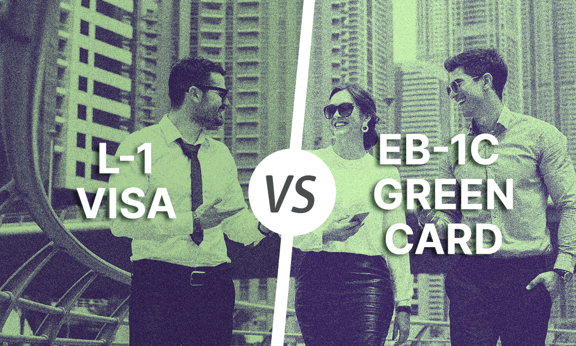Do you dream of living and working in the United States permanently? If so, you might be able to get a green card.
A green card, or a permanent resident card, lets you stay, work, and travel in the United States as long as you follow the rules.
There are different ways to get a green card, depending on your situation and qualifications. One of the most common ways is through consular processing (CP).
In this article, we are exploring what is Consular Processing, timeline, fees, and eligibility criteria. For more information you can get in contact with us.
What is Consular Processing?
Consular processing means that you apply for a green card at a U.S. embassy or consulate in your home country or another country where you have legal permission to be.
Consular processing(CP) is different from the adjustment of status(AoS), which means that you apply for a green card from inside the United States.
For more information about Adjustment of Status read our article!
Steps for Consular Processing
The steps for applying for a green card through CP are different for each case and each type of permanent resident card. But the general steps are:
Step 1: Find Out If You Qualify and Which Category You Belong To
The first step is to find out if you can get a green card and which category you fit into. There are different categories of it, like family-based, employment-based, diversity lottery, humanitarian, and special immigrants.
Step 2: Have Someone File a Petition for You
The next step is to have someone file a petition for you with USCIS. A petition is a form that shows your relationship with the person who files it and why you deserve a permanent resident card. The petition has to be approved by USCIS before you can go on with consular processing.
The most common types of petitions are Form I-130 for family-based Green Cards, Form I-140 for employment-based Green Cards, and Form I-360 for special immigrants.
Addition to sponsorship, you can file your self-petition for some cases such as EB-2 NIW. As a consequence, there’s no need to get a sponsorship for such options.
See Employment-Based Green Cards
Step 3: Wait for Your Turn to Apply for a Green Card
After your petition is approved, you will get a priority date, which is the date when your petition was filed or accepted by USCIS. Your priority date decides when you can apply for a Green Card.
You can check the monthly Visa Bulletin published by the U.S. Department of State (DOS) to see if your priority date is current or not.
If your priority date is current, it means that there are enough immigrant visas for your category and country, and you can go on with CP. If your priority date is not current, it means that there is a waiting list or delay for your category and country, and you have to wait until your priority date becomes current.
Step 4: Fill Out Form DS-260 Online
Once your priority date is current, you are eligible to proceed through the National Visa Center (NVC), which is an agency that handles the processing of immigrant visa applications for DOS. The NVC will tell you to fill out Form DS-260 online, which is an application for an immigrant visa and a Green Card.
Step 5: Pay the Fees
After filling out Form DS-260 online, you will have to pay two fees: the immigrant visa fee and the USCIS immigrant fee. The fees are different depending on your category and country of origin.
Your DS-260 application will be rejected if you do not pay the fees in the correct amount and to the correct departments.
Step 6: Attend Your Interview
The last thing you need to do is to go to the U.S. embassy or consulate where you applied for your permanent residency and have an interview with a consular officer. This is a very important part of the process, because it’s your chance to show that you qualify to live in the US.
Before your interview, you will get a notification from the U.S. embassy or consulate, telling you when and where your interview will be, and what documents you need to bring with you.
At your interview, you will have to show your original documents, like your passport, birth certificate, marriage certificate, police clearance certificate, medical exam report, and financial proof. You will also have to give your fingerprints and swear to tell the truth. The consular officer will then ask you questions about your application and your eligibility for a permanent resident card.
The consular officer will also check if there is any reason why you can’t come to the United States, like having a criminal record, a contagious disease, a security risk, or a previous immigration problem. If there is such a reason, you might be able to ask for a waiver of inadmissibility, which is a way of asking for permission to enter the US.
The consular officer will then make a decision on your application. If your application is approved, you will get a visa packet that has your immigrant visa and other documents. You should not open this packet until you get to the border in the United States. If your application is denied, you will get a notice that tells you why and if you can appeal or try again.
Who Can Apply for a Green Card with Consular Processing?
Consular processing is an option for anyone who meets these requirements:
– You are outside the United States or willing to leave the United States to apply for permanent residency.
– You have an approved petition from a U.S. citizen or permanent resident relative, a U.S. employer, or another qualified entity.
– You have a current priority date based on the availability of immigrant visas in your category and country of origin.
– You qualify and are allowed to come to the US under the immigration laws and rules.
CP is not an option for anyone who meets these requirements:
– You are already in the US on a valid nonimmigrant visa or parole status and eligible to apply for adjustment of status.
– You entered the US illegally or stayed longer than your visa allowed without permission.
– You have been deported out of the US or have an order to leave.
– You have been banned from entering the US because of previous immigration violations or fraud.
Consular Processing vs Adjustment of Status
There are two ways you can apply for permanent residency. As we have mentioned above the first one is consular processing and the second one is adjustment of status.
CP means you apply from outside the United States at a U.S. embassy or consulate, while adjustment of status means you apply inside the United States at a USCIS office. Both ways have their pros and cons, depending on your situation and what you want.

Some of the things that might affect your choice between CP and AoS are:
– How long it takes: CP is usually faster than adjustment of status because it has fewer steps and agencies involved in the United States. But CP can also face delays because of visa availability, security checks, extra processing, workload of official departments, or local issues at the U.S. embassy or consulate.
– How much it costs: CP is usually cheaper than adjustment of status because it has fewer fees and costs. But it can also have extra costs like travel expenses, translation fees, courier fees, or consultation fees.
– How risky it is: CP is riskier than adjustment of status because it requires you to leave the United States if you are already here on a temporary visa and come back with an immigrant visa. This means that you might face more questions at the border or be denied entry if they find any reason why you can’t come to the United States.
Adjustment of status does not require you to leave or come back to the United States and lets you stay in legal status while your application is pending. On the other hand, you may face some difficulties adjusting your status because of eligibility criterias.
– What benefits it has: CP has fewer benefits than adjustment of status because it does not let you work or travel in the United States while your application is pending. Adjustment of status lets you apply for work authorization and travel permission while waiting for your Green Card approval.
In the end, the best option for you depends on your personal situation and goals. You should talk to an immigration lawyer or an accredited representative before making a decision.
What is the Consular Processing Timeline?
The consular processing timeline is how long the whole process takes from when you file the petition to when you get the permanent resident card. The timeline can vary depending on your category, country, and case details, but the average time is about 12 to 18 months.
The Consular Processing timeline has four stages:
– The petition stage.
– The NVC stage.
– The interview stage.
– The visa issuance stage.
You can check the status of your application at each stage on official Consular Electronic Application Center
Calling or sending email could not be a good option to get a quick answer considering the workload in consulates and other official immigration centers.
What are the Consular Processing Fees?
When you apply for permanent residency through CP, you have to pay some fees for your application. These fees are not refundable and not transferable, even if your application is rejected or canceled.
The fees for CP have two parts:
– The immigrant visa fee: This is the fee that you have to pay to the NVC before you fill out Form DS-260 online. How much you have to pay depends on your category and country of origin.
– The USCIS immigrant fee: You pay this fee to USCIS after you get your immigrant visa and before you enter the United States. The fee is $220 for everyone.
Besides these fees, you might also have to pay for other things, such as:
– The Petition Filing Fee
– The Medical Exam Fee
– The Translation Fee
– The Travel Expense
– The Consultation Fee
You should keep receipts or proof of payment for all the fees and expenses related to CP, as you might need them for your records or for later use.
How to Check the Status of My Green Card Application
You can check your application status anytime by using online tools or contacting the agencies involved. Here are some ways to check your application status:
– Case Status Online: This is an online tool from USCIS that lets you check the status of your petition and other applications filed with USCIS. You will need your receipt number.
– CEAC Status Check: This online tool by DOS helps you check the status of your immigrant visa application and pay the fees you need to pay. You will need your case number and invoice number.
– Visa Status Check: Through this tool, you can check the status of your visa after your interview at the U.S. embassy or consulate.
– U.S. Embassy or Consulate: You can also call or email the U.S. embassy or consulate where you applied for your Green Card to check the status of your application. You will need your case number, passport number, and other personal information.
– USCIS Contact Center: You can alternatively call, email, or mail USCIS also to check the status of your petition and other applications filed with USCIS.
What if My Green Card Application is Rejected?
If they say no to your application, it means that you don’t qualify for a Green Card based on what you told them and what documents you gave them. You will get a notice from the U.S. embassy or consulate that tells you why they said no and if you can appeal or try again.
The most common reasons for rejection are:
– Incomplete or inaccurate application
– Inadmissibility
– Fraud or misrepresentation
– Visa unavailability
If your application is rejected, you may have some options to overcome the rejection, such as:
– Correcting or updating your application
– Applying for a waiver of inadmissibility
– Appealing or reapplying
If your consular process for Green Card application has been rejected, don’t lose hope. Contact our experienced attorneys at Grape Law for a consultation.
What is Next After I Hold a US Green Card?
You must be excited to finally have your Green Card and become a permanent resident of the United States. This means you can live, work, and travel in the U.S. as long as you keep your status. You can also apply for citizenship someday if you want to. And you can help your family members get their permanent residency permit too.
Know more about Family Green Cards.
But being a permanent resident also comes with some duties and rules that you need to follow. For example, you have to pay taxes and follow the law, just like everyone else. You also have to keep your permanent residency updated and let USCIS know if you move to a new address. And you have to respect the U.S. Constitution and the way the government works there.
If you still have any questions or worries about Consular Processing, get a professional consultation today from Grape Law. We can help you understand the application and document process.
FAQs on the Consular Processing
How Long is Consular Processing Taking?
Consular processing timeline depends on many factors and it can take months or years by your application.
Can You Enter The U.S. While Consular Processing?
No, you cannot enter the U.S. while Consular Processing unless you have a valid nonimmigrant visa or another entry permit. Otherwise, you may be denied.
Is Cp Better Than AoS?
The advantages and disadvantages of Consular Process for Green Card compared to Adjustment of Status depends on your situation and preferences. You should consider your eligibility, location, travel plans, time, and costs.
Can You Travel With CP?
You are not allowed to enter the U.S. while the Consular Processing application is pending. On the other hand, there’s no restrictions for other countries. Also, you can visit the U.S. with a valid non-immigrant visa.
What Happens After CP?
You get an immigrant visa stamp and a sealed packet of documents. Enter the U.S. and get your Green Card by mail.
Can CP Be Denied?
Yes, for various reasons, such as: ineligibility, fraud, crime, security, health, public charge, or errors.
What Documents are Needed for Consular Processing?
It varies, but generally: a passport, birth certificate, marriage certificate (if any), police certificate, medical report, affidavit of support, proof of relationship (if any), and other documents are needed.
How Do I Start CP?
You need an approved petition and an available visa number. Pay the fees and submit the online form and documents. Schedule and attend an interview.
How Much Does CP Cost?
It varies by your application. You need to pay USCIS filing fee, Department of State fee, medical exam fee, and other fees such as consultation and travel costs.
I Have An Approved I-130. How Much Longer Can I Get A Green Card?
You still need to wait for a visa number to be available. Check the Visa Bulletin online. Then proceed with CP or AoS.
Can I Visit The US With A Pending I-130 Petition?
Yes, if you have a valid nonimmigrant visa or another entry authorization. But prove that you don’t intend to stay or adjust status. And avoid staying too long or making frequent trips.
Categories











